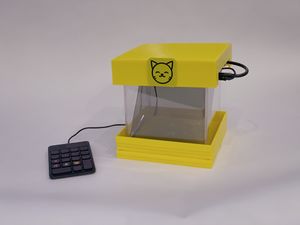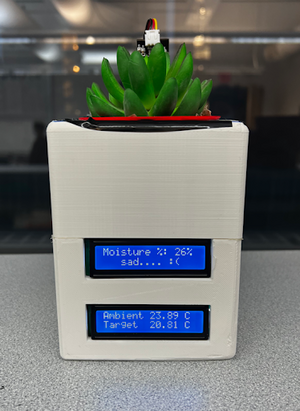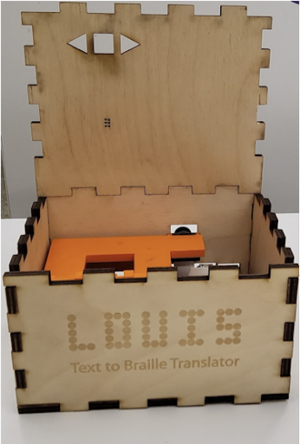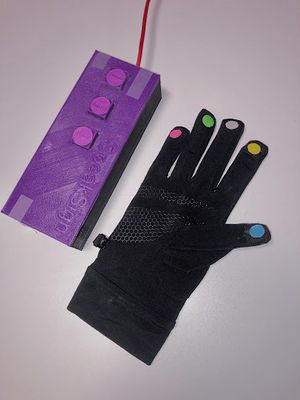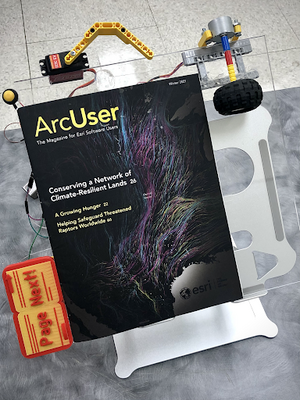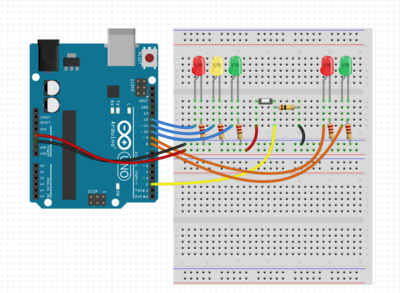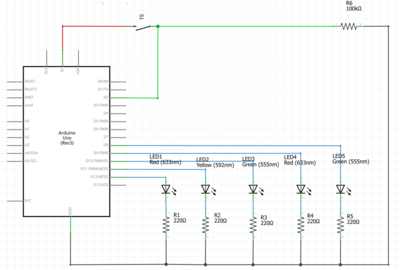Difference between revisions of "Rapid Assembly and Design Challenge (RAD)"
| Line 2: | Line 2: | ||
[[RAD Project Ideas]] | [[RAD Project Ideas]] | ||
= Introduction and Overview = | = Introduction and Overview = | ||
In a rapidly progressing and innovation-focused world, there is | In a rapidly progressing and innovation-focused world, there is a constant push for revolutionary new ideas. Now the National Academy of Engineers (NAE) and the NYU Tandon School of Engineering are seeking proposals to develop unique and intriguing technology that will promote advancement and improve quality of life. The NAE wants to see how the new generation of engineers will address the NAE's Engineering Grand Challenges and technological problems the world faces. The grantors want to reward innovative and exceptional designs and prototypes. | ||
Respondents are tasked with identifying a problem that needs to be solved. The response must include a proof of concept solution in the form of a working prototype that will be showcased to professors, teaching assistants, and other stakeholders. The prototype must show creativity, promise, and innovative excellence. The goal of this endeavor is to address an engineering problem that can be solved. Respondents have the freedom to propose any idea that has merit, be it a new technology or an existing technology that can be improved or adapted to a new use. Proposals that are selected will move forward and produce a prototype by the end of the semester. | |||
= Specifications = | = Specifications = | ||
A sophomore, junior, or senior mentor from the General Engineering Program will be provided. This mentor will be a guide throughout the duration of this project. The mentor will set the requirements for the project, and stay in contact about the deliverables and deadlines. Each project will have a theoretical budget of $100.00 to be spent on components for the prototype. The project must stay within this budget. | |||
Each project must complete two Benchmarks, A and B. Three Milestone presentations will be made over the course of the semester. They should demonstrate steady progress over the 10 week duration of the project showing component testing and later prototype testing. The prototype must complete commissioning. Final submission and a final presentation will complete the project. Prototypes will be judged by professors at the end of the semester, and the best projects will be awarded a prize. | |||
In addition to the mentor, Open Lab (OL) TAs on-shift during Open Lab hours will provide assistance. The OL TAs will help solve problems, or connect respondents with other TAs for specialized help and training. | |||
The Research & Development Committee of EG1004 has developed a Technical Online Library to provide resources in web development, cybersecurity, game development, app development, programming languages, Arduino, Raspberry Pi, LEGO robotics, and more. | |||
*[https://docs.google.com/spreadsheets/d/1X-Sj3W7rKKYeUzUMY5eqmQMuMU6Gh1op5HMCAlGhO-I/edit?ts=5d76dbee#gid=682782030 Technical Online Library] | *[https://docs.google.com/spreadsheets/d/1X-Sj3W7rKKYeUzUMY5eqmQMuMU6Gh1op5HMCAlGhO-I/edit?ts=5d76dbee#gid=682782030 Technical Online Library] | ||
| Line 22: | Line 22: | ||
== Example Project Ideas == | == Example Project Ideas == | ||
Please review the video at the link below to see examples of RAD projects submitted in recent years. | |||
* [https://youtu.be/GmUpPuMvyNo RAD Video 1] | * [https://youtu.be/GmUpPuMvyNo RAD Video 1] | ||
Access this Google document for more information on [https://docs.google.com/document/d/1BBSNUqP8Km-ZWUfmNcJbAfgTkfYmRVzxyfj7WiHOYfc/edit?usp=sharing | Access this Google document for more information on [https://docs.google.com/document/d/1BBSNUqP8Km-ZWUfmNcJbAfgTkfYmRVzxyfj7WiHOYfc/edit?usp=sharing project ideas]. | ||
Review the | Review the NAE Grand Challenges for Engineering and the United Nations Sustainable Development Goals reports to identify a global challenge that a RAD project can address. | ||
* National Academy of Engineering. (2008). Grand Challenges for Engineering. The National Academies Press. Updated 2017, Retrieved from http://www.engineeringchallenges.org/challenges/11574.aspx | * National Academy of Engineering. (2008). Grand Challenges for Engineering. The National Academies Press. <!-- Updated 2017, Retrieved from http://www.engineeringchallenges.org/challenges/11574.aspx --> | ||
* United Nations Educational, Scientific and Cultural Organization. (2017). Education for sustainable development goals: Learning objectives. UNESCO Publishing. Retrieved from https://unesdoc.unesco.org/ark:/48223/pf0000247444 | * United Nations Educational, Scientific and Cultural Organization. (2017). Education for sustainable development goals: Learning objectives. UNESCO Publishing. <!-- Retrieved from https://unesdoc.unesco.org/ark:/48223/pf0000247444 --> | ||
Please review the examples of earlier prototypes of past RAD projects. The PepperPet was developed to provide support and comfort to people who may not be comfortable talking with friends or family about problems or challenges (Figure 1). | |||
[[Image:RAD Example 1.png|300px|thumb|center|Figure 1: PepperPet]] | [[Image:RAD Example 1.png|300px|thumb|center|Figure 1: PepperPet]] | ||
Terra, the Smart Planter, was created to help people who own plants, but require additional assistance in monitoring a plant's watering needs and maintaining an environment that promotes plant growth and health (Figure 2). | |||
[[Image:RAD_Smartplanter_Example.png|300px|thumb|center|Figure 2: Smart Planter- Terra]] | [[Image:RAD_Smartplanter_Example.png|300px|thumb|center|Figure 2: Smart Planter- Terra]] | ||
The Louis Board (Figure 3) is a text to braille translator that assists people who are blind or have visual impairment. | |||
[[Image:RAD_Louisboard_example.png|300px|thumb|center|Figure 3: Louis Board]] | [[Image:RAD_Louisboard_example.png|300px|thumb|center|Figure 3: Louis Board]] | ||
SpeakSign makes the world more accessible for people who are deaf or hard of hearing by providing a tool that translates American Sign Language to speech and speech to ASL (Figure 4). | |||
[[Image:SpeakSign_Inc..jpeg|300px|thumb|center|Figure 4: SpeakSign Inc.]] | [[Image:SpeakSign_Inc..jpeg|300px|thumb|center|Figure 4: SpeakSign Inc.]] | ||
For people who are engaged in cooking, home repair, or other activities that require that they use both hangs, Page Next can turn the pages of any book they are using as they engage in the activity (Figure 5). | |||
[[Image:Page_Next.png|300px|thumb|center|Figure 5: Page Next]] | [[Image:Page_Next.png|300px|thumb|center|Figure 5: Page Next]] | ||
[[Image:Integrated_Saftey_-_Lady_Bug.png|300px|thumb|center|Figure 6: LadyBug]] | [[Image:Integrated_Saftey_-_Lady_Bug.png|300px|thumb|center|Figure 6: LadyBug]] | ||
The pressure in bottles holding carbonated beverages can make opening those bottles difficult and sometimes manufacturers seal beverage bottles too tight. The FlapOpener solves that problem by giving consumers a quick and easy way to open those bottles (Figure 7). | |||
[[Image:FlapOpener.jpeg|300px|thumb|center|Figure 7: FlapOpener]] | [[Image:FlapOpener.jpeg|300px|thumb|center|Figure 7: FlapOpener]] | ||
| Line 50: | Line 60: | ||
== Drawings == | == Drawings == | ||
Prototype designs must be rendered in computer aided design (CAD) software for Milestone presentations and Benchmarks A and B. While any CAD software is acceptable, EG1004 uses and teaches Fusion 360 for labs and other Semester Long Design Projects (SLDP). [https://www.autodesk.com/products/fusion-360/students-teachers-educators Fusion 360] is the recommended software for this course. Fusion 360 may be downloaded for free using an NYU email address. Other CAD software, such as SolidWorks, Inventor, and Rhino are permitted, but EG1004 does not provide resources in obtaining or learning those programs. All design must show four views of the device: front, top, most detailed side, and isometric. Sensors and motors must be included in each drawing. | |||
Each revision of the design must be documented and all changes must be presented during Milestone presentations. | Each revision of the design must be documented and all changes must be presented during Milestone presentations (Figure 8). | ||
[[Image:RAD_CAD_Drawing.png|400px|thumb|center||Figure 8: Example of CAD Drawing]] | [[Image:RAD_CAD_Drawing.png|400px|thumb|center||Figure 8: Example of CAD Drawing]] | ||
| Line 59: | Line 68: | ||
== Diagrams == | == Diagrams == | ||
The circuit that powers and operates a prototype must be presented as a circuit diagram and a schematic diagram for Milestones, presentations, and Benchmarks A and B. A circuit diagram is a representation of the circuit, showing the physical layout of the wires and how the components are organized (Figure 9). | |||
[[Image:RAD_Circuit_Diagram.png|500px|thumb|center||Figure 9: Circuit Diagram Example]] | [[Image:RAD_Circuit_Diagram.png|500px|thumb|center||Figure 9: Circuit Diagram Example]] | ||
A schematic diagram shows the plans and functions of the circuit, but not the physical layout of the wires (Figure 10). | |||
[[Image:RAD_Schematic_Diagram.png|500px|thumb|center||Figure 10: Schematic Diagram Example]] | [[Image:RAD_Schematic_Diagram.png|500px|thumb|center||Figure 10: Schematic Diagram Example]] | ||
EG1004 recommends the circuitry modeling software [https://www.tinkercad.com/|| Tinkercad] and [http://fritzing.org/|| Fritzing] to fulfill these deliverables. Tinkercad is a free browser-based circuitry software that is especially useful for constructing circuit diagrams with common electrical components. For projects with more complex electrical components, Fritzing is a free circuitry software with | EG1004 recommends the circuitry modeling software [https://www.tinkercad.com/|| Tinkercad] and [http://fritzing.org/|| Fritzing] to fulfill these deliverables. Tinkercad is a free browser-based circuitry software that is especially useful for constructing circuit diagrams with common electrical components. For projects with more complex electrical components, Fritzing is a free circuitry software with a library of electrical components that is useful for constructing circuit diagrams and schematic diagrams. For a guide on using both software, please refer to the [[Virtual Circuit Simulation Guide]]. | ||
Revision as of 04:19, 3 September 2023
Request for Proposal: Rapid Assembly and Design Challenge (RAD)
Introduction and Overview
In a rapidly progressing and innovation-focused world, there is a constant push for revolutionary new ideas. Now the National Academy of Engineers (NAE) and the NYU Tandon School of Engineering are seeking proposals to develop unique and intriguing technology that will promote advancement and improve quality of life. The NAE wants to see how the new generation of engineers will address the NAE's Engineering Grand Challenges and technological problems the world faces. The grantors want to reward innovative and exceptional designs and prototypes.
Respondents are tasked with identifying a problem that needs to be solved. The response must include a proof of concept solution in the form of a working prototype that will be showcased to professors, teaching assistants, and other stakeholders. The prototype must show creativity, promise, and innovative excellence. The goal of this endeavor is to address an engineering problem that can be solved. Respondents have the freedom to propose any idea that has merit, be it a new technology or an existing technology that can be improved or adapted to a new use. Proposals that are selected will move forward and produce a prototype by the end of the semester.
Specifications
A sophomore, junior, or senior mentor from the General Engineering Program will be provided. This mentor will be a guide throughout the duration of this project. The mentor will set the requirements for the project, and stay in contact about the deliverables and deadlines. Each project will have a theoretical budget of $100.00 to be spent on components for the prototype. The project must stay within this budget.
Each project must complete two Benchmarks, A and B. Three Milestone presentations will be made over the course of the semester. They should demonstrate steady progress over the 10 week duration of the project showing component testing and later prototype testing. The prototype must complete commissioning. Final submission and a final presentation will complete the project. Prototypes will be judged by professors at the end of the semester, and the best projects will be awarded a prize.
In addition to the mentor, Open Lab (OL) TAs on-shift during Open Lab hours will provide assistance. The OL TAs will help solve problems, or connect respondents with other TAs for specialized help and training.
The Research & Development Committee of EG1004 has developed a Technical Online Library to provide resources in web development, cybersecurity, game development, app development, programming languages, Arduino, Raspberry Pi, LEGO robotics, and more.
If you require a Raspberry Pi 4, consult your RAD mentor and fill out this request form.
Example Project Ideas
Please review the video at the link below to see examples of RAD projects submitted in recent years.
Access this Google document for more information on project ideas.
Review the NAE Grand Challenges for Engineering and the United Nations Sustainable Development Goals reports to identify a global challenge that a RAD project can address.
- National Academy of Engineering. (2008). Grand Challenges for Engineering. The National Academies Press.
- United Nations Educational, Scientific and Cultural Organization. (2017). Education for sustainable development goals: Learning objectives. UNESCO Publishing.
Please review the examples of earlier prototypes of past RAD projects. The PepperPet was developed to provide support and comfort to people who may not be comfortable talking with friends or family about problems or challenges (Figure 1).
Terra, the Smart Planter, was created to help people who own plants, but require additional assistance in monitoring a plant's watering needs and maintaining an environment that promotes plant growth and health (Figure 2).
The Louis Board (Figure 3) is a text to braille translator that assists people who are blind or have visual impairment.
SpeakSign makes the world more accessible for people who are deaf or hard of hearing by providing a tool that translates American Sign Language to speech and speech to ASL (Figure 4).
For people who are engaged in cooking, home repair, or other activities that require that they use both hangs, Page Next can turn the pages of any book they are using as they engage in the activity (Figure 5).
The pressure in bottles holding carbonated beverages can make opening those bottles difficult and sometimes manufacturers seal beverage bottles too tight. The FlapOpener solves that problem by giving consumers a quick and easy way to open those bottles (Figure 7).
Drawings
Prototype designs must be rendered in computer aided design (CAD) software for Milestone presentations and Benchmarks A and B. While any CAD software is acceptable, EG1004 uses and teaches Fusion 360 for labs and other Semester Long Design Projects (SLDP). Fusion 360 is the recommended software for this course. Fusion 360 may be downloaded for free using an NYU email address. Other CAD software, such as SolidWorks, Inventor, and Rhino are permitted, but EG1004 does not provide resources in obtaining or learning those programs. All design must show four views of the device: front, top, most detailed side, and isometric. Sensors and motors must be included in each drawing.
Each revision of the design must be documented and all changes must be presented during Milestone presentations (Figure 8).
Diagrams
The circuit that powers and operates a prototype must be presented as a circuit diagram and a schematic diagram for Milestones, presentations, and Benchmarks A and B. A circuit diagram is a representation of the circuit, showing the physical layout of the wires and how the components are organized (Figure 9).
A schematic diagram shows the plans and functions of the circuit, but not the physical layout of the wires (Figure 10).
EG1004 recommends the circuitry modeling software Tinkercad and Fritzing to fulfill these deliverables. Tinkercad is a free browser-based circuitry software that is especially useful for constructing circuit diagrams with common electrical components. For projects with more complex electrical components, Fritzing is a free circuitry software with a library of electrical components that is useful for constructing circuit diagrams and schematic diagrams. For a guide on using both software, please refer to the Virtual Circuit Simulation Guide.
Project Schedule
A project schedule must be created in Google Sheets. Please refer to the template provided in your team Google Drive folder and our guide.
This schedule must include all tasks related to the project from the start of the project to Early or Final submission. The project schedule should include:
- Minimum of 20 tasks, excluding Milestones
- Milestones should be clearly indicated on the project plan (duration of zero days)
- Each task must include the person responsible for completing the task (resource names)
- Gantt chart must be displayed alongside the tasks list (fit onto one slide)
- Gantt chart must show a progress line
- Clearly state during the presentations whether the project is on-time, behind schedule, or ahead of schedule
- In milestone presentations, please present a “Project Status” slide, which should summarize key deadlines. You are not required to show your project schedule in these presentations
Cost Estimate
A cost estimate must be generated that specifies the cost of all the materials and labor required for the construction of the proof of concept. Tabulate this cost information clearly in an Excel spreadsheet. Help in calculating the cost is available by reviewing How to plan the schedule and calculate costs for a project. You MUST choose parts for purchase from Amazon for ease of purchasing and faster delivery. Any adjustments or changes over the semester in your cost estimate from the one implemented in your Design & Feasibility Report must be documented and shown to your mentor.
The cost estimate should include the following:
- Labor cost breakdown with hours and rates
- Cost of all materials and components
- Total cost must be shown in the bottom right corner
There should be no decimal places in the cost estimate as this is purely an estimate. Be sure to round appropriately.
Purchasing
You will have a budget of $100 to complete your project. Purchases can be made from materials that EG does not already have. You can find the list of materials available for all RAD groups here:
Purchases can only be made for items on Amazon. You can submit requests to purchase items through the Purchasing Form. After submitting the purchasing form, you must get your purchase approved by your mentor. The Purchasing Form can be found here:
In order to simplify this process, purchases must be approved by midnight. Purchases will be submitted by the department later that week. We cannot guarantee that purchases will arrive in a timely manner - make sure items are prime eligible for faster delivery and the item must ship in less than 7 days. Think ahead and order on time.
Purchase requests must be submitted by 4:30 PM of the following days in order for purchases to go through:
- July 18, 2023 (Week 3)
- July 20, 2023 (Week 4)
- July 25, 2023 (Week 5)
There will be two additional special purchasing deadlines for recipients of the RAD Innovation Grant and groups with extenuating circumstances:
- Not applicable for the summer semester
For any material or advanced print purchase through the MakerSpace, you must fill out the respective form. Once the form is filled out, your purchase must be approved. Material purchases must be approved by your mentor. Print purchases must be approved by a ProtoLab TA. After approval, then you are allowed to go to the MakerSpace to have your request fulfilled. Note: For any advanced prints, one member of the group must have completed prior training for the machine and must be present when completing the request at the MakerSpace.
Weekly Meetings
Your group must schedule and attend weekly meetings with your RAD mentor. Your group must choose a time slot together and abide by that time slot for the remainder of the semester. Your RAD mentor will set your Benchmarks and extra credit tasks. For additional technical help, go to Open Lab and an Open Lab TA will assist you with your project.
CATME
When working on your engineering team projects, peer evaluations and self-evaluations are critical for assessing how effective your contributions are to the team. In our course, your recitation professor will use evaluations at each Milestone using a software called the Comprehensive Assessment of Team Member Effectiveness (CATME). More information can be found on the Teamwork Expectations page.
Engineering Notebook
While working on your project, you are expected to keep a record of all work done, as well as future plans and goals. In order to complete a Benchmark assessment, you must show your Engineering Notebook to the Open Lab TA completing your assessment. For Milestones and Final Submission, you must have it approved by your Recitation Professor and be prepared to make it available to an Open Lab TA in a Word Document (DOC or DOCX) format. A guide to writing the notebook, as well as a basic overview of its expectations and frequency at which you should log in your notebook, can be found on the Keeping an Engineering Notebook page.
Milestones, Benchmarks, and Deliverables
As you work on your project, you will be required to present periodic reports on your progress. We call these Milestones. All the items assigned in each phase of the project are called Benchmark deliverables. These deliverables often consist of a combination of written submissions, presentations, and demonstrations. Additionally, you will be required to meet certain benchmarks assigned by your mentor, and hand in reports/deliverables that add to the progress and comprehensiveness of your project. The 3D Printing and Logo Guide page contains information on the 3D printing requirements and guidelines.
Note: You are only allowed to get a benchmark and commission approval from a TA at the end of Lab, during Open Lab times, or during scheduled meetings with your RAD Mentor.
Preliminary Design Investigation
The Preliminary Design Investigation (PDI) is extremely important, as it lays the groundwork for your project. You will be outlining your project idea, inspiration, and goals.
The PDI must include:
- Cover Page
- Project Overview
- Goals & Objectives
- Design & Approach
- Cost Estimate
- Project Schedule
- Relevant Pictures
An example PDI template can be found here. The PDI is due to your mentor by email by Benchmark A. Do not forget to include the items listed above, but do not feel limited to only these items. Use this link to access the PDI Rubric.
Milestone 1
Milestone 1 is a presentation of your Preliminary Design Investigation Report. It is important that you outline your project goals and show that your project is realizable.
Your Milestone 1 presentation must include:
- Company profile
- Company name
- Product name
- Group member title(s)
- Mission statement
- Project Objective
- What is your project about?
- What tasks are you aiming to accomplish? (Benchmark A requirements)
- Overall design approach to complete objective
- Background Information
- Why is the project happening?
- What does the audience need to know?
- Technical design description
- Preliminary conceptual drawing of design
- Rendered and digital sketches are acceptable, CAD not required
- What components will be used and why?
- Preliminary conceptual drawing of design
- Cost estimate
- Major components of design listed
- Miscellaneous category listed
- Projected labor listed
- Microsoft Project schedule
- Click here to access the guide on how to transfer a file
- Teamwork agreement summary
- Summary
- Overall assessment on current state of project
- Are you on schedule? Are you on budget?
- Next steps and future tasks
Look Ahead: What tasks are planned between now and Milestone 2?
See How to Give a Milestone Presentation for the format of a Milestone presentation. Because your project will differ in format from other SLDPs, please treat this How-To as a general guideline but not an exact template. Your personalized Benchmark A requirements will be given to you by your mentor, and you have some creative freedom with the format of your presentation.
Benchmark Assessment A
Benchmark assessments evaluate the progress of your project. Benchmark Assessment A is due at the end of Model Shop Session II. There are penalties for not completing this on time. Refer to the EG1004 Grading Policy for more information.
For your Benchmarks, your mentor will outline specific goals that your project must achieve to satisfy the Benchmark. These goals will vary depending on the project and mentor and will be determined based on the particular project's level of difficulty. Please be sure to submit your Benchmark deliverables via the EG1004 website.
Part of your Benchmark is completing and turning in your PDI. When you showcase the rest of your Benchmark requirements to an Open Lab TA, every part of the PDI must be completed in order to Benchmark.
To pass, the design must complete all of the following:
- Tasks assigned by your mentor
- Initial CAD model
- Preliminary Design Investigation
- Submit an .STL and a .3mf (Cura Project file) of the team logo through the 3D Printing Submission portal on the EG website
- The 3D Printing and Logo Guide contains information on the 3D printing requirements and guidelines.
- The Protolab schedule is available on the 3D Printing and Logo Guide
- Updated Engineering Notebook
Milestone 2
See How to Give a Milestone Presentation for the format of a Milestone presentation, but remember that your format will differ slightly. The specifications for the presentation are stated below.
Milestone 2 is a project progress update. You must explain all changes and developments made thus far, particularly in regards to Benchmark A. Include whether or not you were able to complete your Benchmark A requirements, and if not, explain why. Also, highlight any changes you plan on making to your design or project, in general.
Your Milestone 2 presentation must include:
- Company profile
- Company name
- Product name
- Group member title(s)
- Mission statement
- Project Objective
- What is your project about?
- What tasks are you aiming to accomplish? (Benchmark A/Benchmark B requirements)
- Overall design approach to complete objective
- Background Information
- Why is the project happening?
- What does the audience need to know?
- Technical design description
- Explanation of design changes, if any
- CAD drawings: top, front, most detailed side, and isometric view
- Circuit and schematic diagram(s)
- Relevant pictures
- Flowchart of code
- Cost estimate (previous and current costs)
- Major components of design listed
- Miscellaneous category listed
- Projected labor listed
- What changes were made, if any?
- Microsoft Project schedule (previous and current).
- What changes were made?
- Click here to access the guide on how to transfer a file
- Summary
- Overall assessment on current state of project
- Are you on schedule? Are you on budget?
- Next steps and future tasks
Look Ahead: What tasks are planned between now and Milestone 3?
Benchmark Assessment B
Benchmark Assessment B is due at the end of Model Shop Session III. There are penalties for not completing this on time. Refer to the EG1004 Grading Policy for more information.
Similar to Benchmark A, your Benchmark B requirements will be determined and outlined by your mentor. Please submit your Benchmark deliverables via the EG1004 website.
To pass, the design must complete all of the following:
- Tasks assigned by your mentor
- Updated CAD Model
- Have an .STL and a .3mf (Cura Project file) of the team logo approved by a ProtoLab TA through the 3D Printing Submission portal on the EG website. Students must physically go to the Protolab before their Modelshop Session 3 to get their logo approved. Logos cannot be approved during Modelshop sessions.
- The 3D Printing and Logo Guide contains information on the 3D printing requirements and guidelines
- The Protolab schedule is available on the 3D Printing and Logo Guide
- Updated Engineering Notebook
Milestone 3
See How to Give a Milestone Presentation for the format of a Milestone presentation, but remember that your format will differ slightly.
Milestone 3 is the last project progress update. You must explain all changes and developments made thus far, particularly in regards to Benchmark B. Include whether or not you were able to complete your Benchmark B requirements, and if not, explain why. Also, highlight any changes you plan on making to your design or project, in general.
Your Milestone 3 presentation must include:
- Company profile
- Company name
- Product name
- Group member title(s)
- Mission statement
- Project Objective
- What is your project about?
- What tasks are you aiming to accomplish? (Benchmark A/Benchmark B/Commissioning requirements)
- Overall design approach to complete objective
- Background Information
- Why is the project happening?
- What does the audience need to know?
- Technical design description
- Explanation of design changes, if any
- CAD drawings: top, front, most detailed side, and isometric view
- Circuit and schematic diagram(s)
- Relevant pictures
- Flowchart of code
- Cost estimate (previous and current costs)
- Major components of design listed
- Miscellaneous category listed
- Projected labor listed
- What changes were made, if any?
- Microsoft Project schedule (previous and current).
- What changes were made?
- Click here to access the guide on how to transfer a file
- Summary
- Overall assessment on current state of project
- Are you on schedule? Are you on budget?
- Next steps and future tasks
Look ahead: What tasks are planned between now and the completion of the project?
Commissioning
Projects must be commissioned before Submission. Refer to the syllabus for Submission deadlines. There are penalties for not completing this on time. Refer to the EG1004 Grading Policy for more information.
To Commission, the following must be completed:
- Fully-functional prototype
- Any additional deliverables designated to you by your mentor
- Have an .STL file of the team logo printed through the 3D Printing Submission portal on the EG website
- The 3D Printing and Logo Guide contains information on the 3D printing requirements and guidelines.
- The Protolab schedule is available on the 3D Printing and Logo Guide
- Updated Engineering Notebook
Extra Credit
RAD Groups have multiple options for receiving extra credit:
- Extra credit tasks determined by your mentor or professor based on your specific RAD project. Usually, your mentor or professor will give you an additional 2 tasks to complete by Commissioning, which can be up to 6 points total. Some examples may include:
- Website integrated with product
- App integration that provides additional functionality
- Wireframe app design
- Informational website
Additional extra credit opportunities are as follows:
- Completing Benchmark A, Benchmark B, or Submission early
Refer to the EG1004 Grading Policy for exact point values. Creativity and innovation are always rewarded. Original designs will receive extra credit at the discretion of your Recitation professor.
Final Design Report
The Final Design Report (FDR) provides a comprehensive overview of your project process and developments from initial brainstorm to finished proof of concept. All project expectations and outcomes must be clearly detailed in the document. This report will also provide you with documentation experience useful for completing your Senior Design final report and other projects.
The Final Design Report must include the following documentation:
- CAD drawings
- Wiring diagrams
- Project schedule
- Cost estimate
Use this Final Design Report template with the following outline:
- Introduction
- Purpose of Project
- Background
- Requirements
- Physical Components
- Software Components
- Procedures
- Physical Construction
- Software Setup
- Software Troubleshooting
- Milestone and Final Product Requirements
- Benchmark A Requirements
- Benchmark B Requirements
- Final Submission Requirements
- Human Resources and Training (e.g. TA expertise utilized, etc.)
- Results
- Benchmark A Results
- Benchmark B Results
- Difficulties Experienced
- Conclusion
- Results of Project
- Future Improvements
The FDR is due at the time of submission.
Final Presentation
Final presentations for RAD teams are not like the Milestone presentations. Students will be doing a business pitch to showcase their work, their product, and their business. This pitch involves a 5 minute presentation to show who you are, your business, and pitching your project to theoretical investors. Focus on topics such as the project application, a target audience for this product, why it's different from other products on the market, and the product's market value. The presentation should be colorful and coordinated. There should be equal amounts of graphics and text. You should focus on keeping your audience engaged and interested in your product as you go through the presentation. Feel free to be creative with the Final Presentation!
Your Final Presentation must include:
- Company Profile
- Company name
- Employee profile, role(s), and qualifications
- Mission statement
- Problem statement
- Why is the project happening?
- What does the audience need to know?
- Product objective
- What is the purpose of your product?
- Who does your product help?
- What problem does your project solve?
- Product description
- CAD drawings: top, front, most detailed side, isometric
- Circuit diagram(s)
- Flowchart of code
- Market and product viability
- Does your company have competitors?
- What makes your product unique?
- How does your design compare to competitors - cost, quality, features?
- Is the product versatile?
- Who will buy your product?
- What is the price of your product?
- Conclusion
- Reiterating product purpose
- Highlight product features
- Future goals of the company
- Video advertisement
- Price of product
- Demonstration of product
- Embedded into Final Presentation
Some examples of RAD Final Presentations can be seen below. A video advertisement must be included in the presentation.
Submission
All SLDPs must submit online. Please visit https://eg.poly.edu/finalSLDP.php for the link to the Project Submission form and each SLDP group's individualized login information. To submit, you must login to the EG1004 website using this special login information. Submitting with your NYU account or any other account will generate an error. You may resubmit at any time before the deadline. Please note that submission times are based on the most recent submission.
Please note the deliverables for this project are as follows. If any of the following items are omitted, you will be penalized. Be sure to click submit at the bottom of the form.
The following list are general items that are expected from all RAD groups:
- Final presentation
- Circuit Diagram
- Schematic Diagram
- Code Flowchart
- Commented code
- All CAD drawings of your design (initial through final)
- Video advertisement of the prototype in use
- Final Microsoft Project schedule
- Final cost estimate
- Resume(s) (no fictitious resumes will be accepted)
- Final Engineering Notebook
- Final Design Report
Late Submission
Late submission is not allowed. If a project does not Commission or receive Partial Commission by the deadline set forth in the syllabus, the project will not be allowed to submit and will receive a 0 for the project grade. To receive Partial Commissioning, two TAs must evaluate the project and determine its degree of completion according to the Commissioning requirements and the project will be given a grade accordingly. Please refer to the EG1004 Grading Policy for more information.
Frequently Asked Questions
Q: What happens if we want to change our project idea?
A: Project changes are reviewed by your RAD mentor and Professor on a case-by-case basis. Please talk to your mentor if you would like to pivot your project.
| ||||||||
